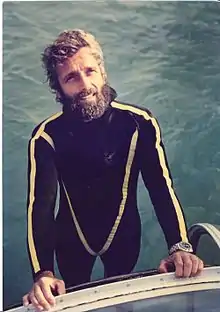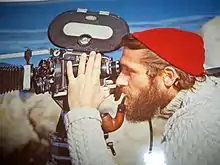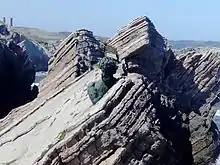Philippe Cousteau
Philippe Pierre Cousteau (30 December 1940 – 28 June 1979) was a French diver, sailor, pilot, photographer, author, director and cinematographer specializing in environmental issues, with a background in oceanography. He was the second son of Jacques Cousteau and Simone Melchior.
Philippe Cousteau | |
|---|---|
 Cousteau after a dive off the island of Isabella, near Mazatlan, Mexico, in 1975 | |
| Born | Philippe-Pierre Cousteau 30 December 1940 Toulon, France |
| Died | 28 June 1979 (aged 38) Tagus River, Alverca, Portugal |
| Nationality | French |
| Spouse(s) | |
| Children | Alexandra Cousteau Philippe Cousteau Jr. |
| Parent(s) | Jacques Cousteau Simone Melchior |
Philippe Cousteau was proficient filming from the air, on land and underwater. He was the lead cinematographer for most of the Cousteau films during his lifetime;[1] he was nominated for and won several awards.[2]
Early life and education
Born in Toulon, Philippe Cousteau first dived with an aqua-lung in 1945 when he was 4 years old. His father brought home a miniature version of the aqua-lung he had co-invented a few years before. Though Philippe had not yet learned to swim, he followed his father into the water. Growing up, he spent each school vacation aboard his father’s ship, RV Calypso.
As a teenager, he began to feel the drive to explore. While his father had pursued the horizon on the sea, Philippe Cousteau dreamed of pursuing horizons in the sky and began to study aerodynamics at the age of 16, flying first as a glider pilot, and then earning his airplane pilot license at a young age.[3]
Cousteau spent two years in the French Navy during the Algerian war as a sonar operator and member of the landing party of the Le Normand ship, later earning his degree in science, spent another year at MIT, and then went to Paris to train in cinematography, graduating from I'École technique de photographie et de cinéma (now called École nationale supérieure Louis-Lumière) in Paris.
Biography
Philippe Cousteau

In 1965, Cousteau was an Oceanaut on the Conshelf III, an undersea habitat for saturated diving down to 325 feet near Ile Levant in the Mediterranean Sea. In addition to his duties as Oceanaut, Cousteau was an underwater photographer and did all of the underwater filming, which became a National Geographic documentary film that aired in 1966.
Cousteau appeared as himself on the March 28, 1966 episode of the CBS game show To Tell the Truth. He received three of the four possible votes from the panel.[4]
In February 1967, Cousteau accompanied his father on the RV Calypso for an expedition to film the sharks of the Red Sea and the Indian Ocean. As well as being the lead photographer for the expedition, Cousteau also chronicled his experiences in the 1970 publication The Shark: Splendid Savage of the Sea.
In 1969, Cousteau lent his technical expertise to the U.S. Navy's SEALAB program. In the aftermath of aquanaut Berry L. Cannon's death while attempting to repair a leak in SEALAB III, Cousteau volunteered to dive down to SEALAB and help return it to the surface, although SEALAB was ultimately salvaged in a less hazardous way.[5]
Until his death in 1979, he co-produced numerous documentaries[1] with his father, including Voyage to the Edge of the World (1976, for the cinema theatres) and his own PBS series, Oasis in Space[6] (1977, for the television), concerning environmental issues.
Piloting

Philippe Cousteau was a highly experienced pilot. He earned his glider pilot license at the age of 16 and went on to obtain pilot credentials to fly balloons, hang gliders, single- and multi-engine airplanes and seaplanes, gyrocopters and helicopters.[3]
He acquired a PBY Catalina seaplane in 1974. The amphibious aircraft was a converted U.S. Navy Catalina flying boat. Christened the Flying Calypso, the aircraft was in many of the Cousteau films and the home base for Cousteau's team.[7]
Personal life
Cousteau met Janice Sullivan in the crowded ballroom of St. Regis Hotel in New York City, USA, in February 1966. She was a fashion model originally from Los Angeles and more recently from New York. On 10 February 1967, they were married in Paris, France. Sullivan joined Cousteau on most of his father's expeditions (20 of 26 filming expeditions that spanned 13 years). They had two children, Alexandra Cousteau and Philippe Cousteau Jr.[8]
Death
Cousteau died in 1979, aged 38, when his PBY Catalina flying boat crashed in the Tagus river near Lisbon. The aircraft nosed over during a high-speed taxi run undertaken to check the hull for leakage. The propeller detached from the engine and killed Cousteau instantly. All others on board survived.[9] His son Philippe Cousteau Jr. was born six months later.
Awards
Philippe Cousteau received many awards and honors for his contribution to diving and underwater photography: He was nominated for four Emmy's,[2] NOGI Award for Arts from the Underwater Society of America (now presented by The Academy of Underwater Arts and Sciences) (1977),[10] World Wildlife Award and many others.
Legacy

The Philippe Cousteau Anchor Museum in Asturias, Spain, honors the oceanographer.
The Lycée Philippe Cousteau in Saint-André-de-Cubzac, France honors his work.[11]
His children Alexandra Cousteau and Philippe Cousteau Jr. continue the family work in oceanography as the co-founders of EarthEcho International.
Notes
- "Philippe Cousteau Sr". IMDb. Retrieved 29 August 2017.
- "Philippe Cousteau Sr". IMDb. Retrieved 29 August 2017.
- "St. Petersburg Times – Google News Archive Search". news.google.com. Retrieved 29 August 2017.
- "To Tell the Truth". CBS. Retrieved 2 May 2020.
- Craven, John Piña (2001). The Silent War: The Cold War Battle Beneath the Sea, New York: Simon & Schuster. ISBN 0-684-87213-7.
- "Cousteau Oasis in Space". Television Academy. Retrieved 29 August 2017.
- "Catalina PBY – Cousteau". cansonet.free.fr. Retrieved 29 August 2017.
- "Jan and Alexandra Cousteau celebrate the family business of conservation". Retrieved 29 August 2017.
- Aviation Safety Network. "ASN Aircraft accident Consolidated PBY-6A Catalina N101CS Alverca". Retrieved 18 July 2010.
- User, Super. "OG Explorers – Oscars of the Ocean". www.underwaterartists.com. Retrieved 29 August 2017.
- "Site internet du lycée Philippe Cousteau, Saint-André de Cubzac". webetab.ac-bordeaux.fr. Retrieved 29 August 2017.
External links
- Photo of Philippe Cousteau at the controls of N101CS.
- Photo of Philippe Cousteau.
- Cousteau Society PBY-6A Catalina as piloted by Philippe Cousteau.
- Official Aircraft Accident Description N101CS, Consolidated PBY-6A Catalina, 28 June 1979.
- CDNN- The Cousteau Wars.